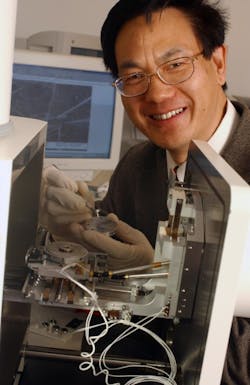Georgia Tech professor wins award for research into zinc oxide nanostructures

Atlanta, GA--Zhong Lin Wang, a professor at the Georgia Institute of Technology (Georgia Tech), has received a Materials Research Society (MRS) Medal for his work on zinc oxide (ZnO2) nanostructures. The medal was presented last week at the 2011 MRS Fall meeting (Nov. 28 to Dec. 2; Boston, MA).
As Wang has discovered, nanowires and other structures ZnO2 have many uses, both photonic and nonphotonic. For example, mechanically strained ZnO2 wires can boost the efficiency of gallium nitride (GaN)-based LEDs. They can also form nanometer-scale piezoelectric devices for building self-powered nanotechnology. Wang has built such generators that produce enough power to operate conventional electronic components like LED displays.More recently, Wang has used the piezoelectric properties of ZnO2 nanostructures to control charge transport in electronic devices, a technology known as piezotronics, which provides an alternative to traditional CMOS technology. He has also coined the term "piezo-phototronics" to describe techniques for controlling electro-optical processes in devices such as LEDs.
Wang has developed piezotronic logic gates and memory, as well as LEDs enhanced with the piezo-phototronic effect. Multiple devices have been combined into self-powered sensing systems that not only detect harmful materials, but also can alert authorities wirelessly. He has also built systems that combine different kinds of power harvesting, such as nanogenerators and photovoltaic cells.
He has formed a startup company to commercialize the technology. Overall, he estimates his research team has produced more than 700 publications that have been cited 45,000 times.
source: http://www.newswise.com/articles/view/583541/?sc=swhr&xy=5039565

John Wallace | Senior Technical Editor (1998-2022)
John Wallace was with Laser Focus World for nearly 25 years, retiring in late June 2022. He obtained a bachelor's degree in mechanical engineering and physics at Rutgers University and a master's in optical engineering at the University of Rochester. Before becoming an editor, John worked as an engineer at RCA, Exxon, Eastman Kodak, and GCA Corporation.